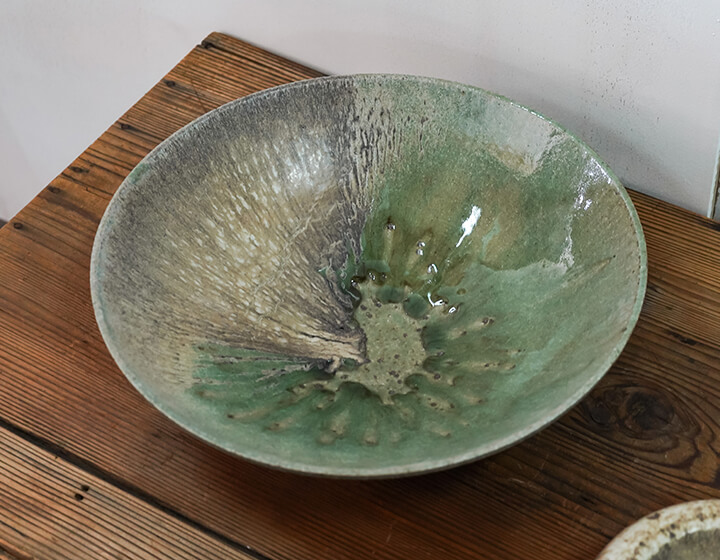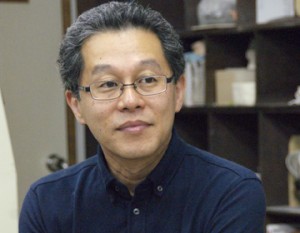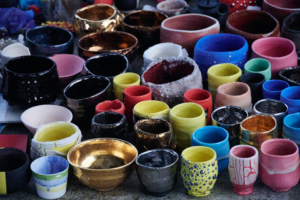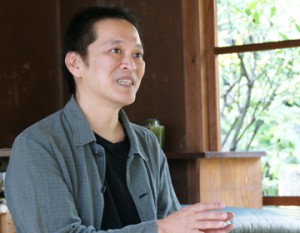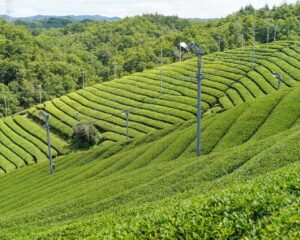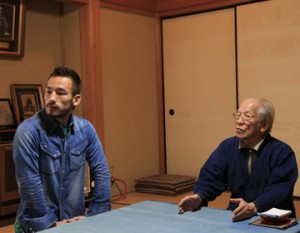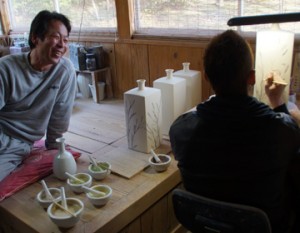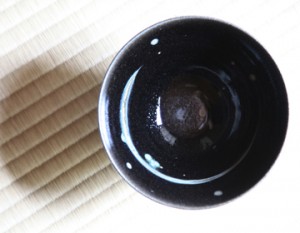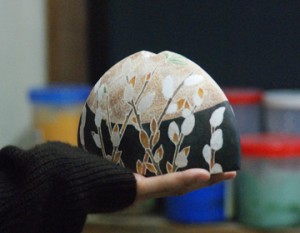A stream of olive-colored glaze covers the well-honed form. The charm of the vessels created by potter Kiyooka Yukimichi is the wide range of color tones created by his uniquely blended glazes. The image of Shigaraki ware is overturned in a good way. Seeking “something that seems to exist but doesn’t,” he is bringing a new wind to Shigaraki ware.
The expression of glaze that stands out in a simple form
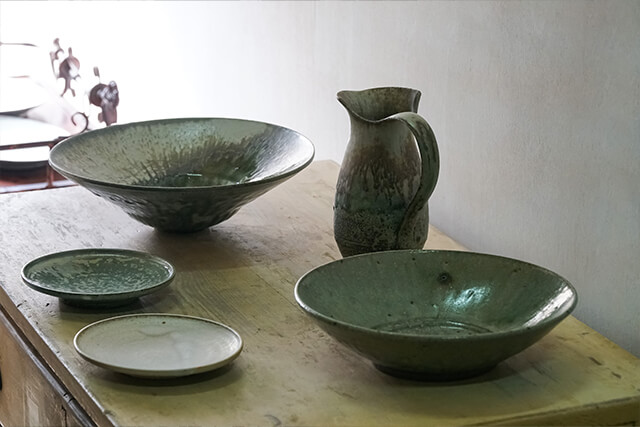
Mr. Kiyooka’s pottery is simple, yet fascinating with its rich and unique expression. The key to this is the use of glaze. He uses a variety of glazes, including shoshakuyu (crystal white glaze) and kaibakuyu (grayish white glaze), which allow the viewer to experience the warmth of the original clay of the pottery, as well as blue ash glaze and olive-colored ash glaze, which have different textures, to create new vessels. He is constantly receiving offers from galleries in Japan and abroad, and is expected to become one of the leading Shigaraki ceramic artists of the future.
At the farthest end of Shigaraki
Mr. Kiyooka’s studio is located in Miyajiri, Shigaraki Town, Koka City, Shiga Prefecture. Shigaraki is a town that has long flourished in the pottery industry because of its high quality clay. Today, Shigaraki has become a tourist spot that attracts many visitors to tour the Shigaraki pottery kilns, but Mr. Kiyooka has set up his workshop in an abandoned factory in the most remote village in Shigaraki. It is a quiet place where you hardly meet anyone,” he says. There are only houses in the surrounding area, and he works alone, carefully and deliberately, on his vessels.
Guided by the clay to Shigaraki
Mr. Kiyooka was born in Tokyo. He grew up in Hokkaido and spent his school years in Yokohama. After that, he entered the Department of Crafts at Osaka University of Arts, which he was interested in because of a childhood friend who had attended the school. However, upon entering, he was not very interested in ceramics as an object, which was taught there. So, after graduating from the university, he decided to pursue a career in manufacturing rather than as an artist, and found employment at a Shigaraki-based ceramics manufacturer that made umbrella stands and other products. When asked why he chose Shigaraki, he replied, “Shigaraki clay was easy for me to handle when I was working at the university. It was not too delicate, and even if I made something rough, it would still be accepted. The clay led Mr. Kiyooka to Shigaraki, a place he had never been to before.
Between the gap between “what is required” and “what I want to make
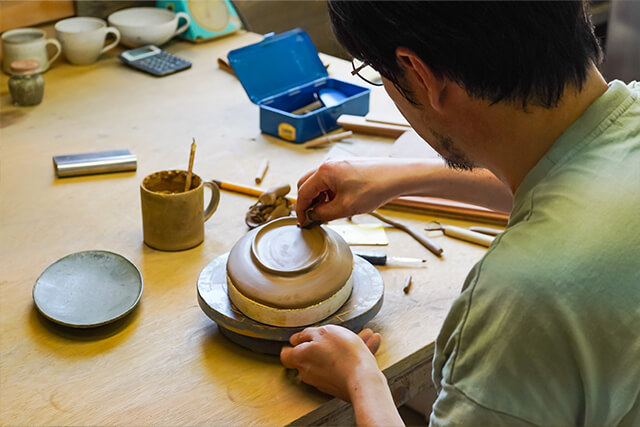
A turning point for Mr. Kiyooka came when he had lived in Shigaraki for several years. He was asked by the owner of a restaurant he knew to make some vessels for him. He asked me to do as I pleased. I was asked to do as I pleased, and it turned out to be more popular than I had imagined. I thought, ‘This is the most interesting job I’ve ever had,'” he says. This experience sparked Mr. Kiyooka’s creativity.
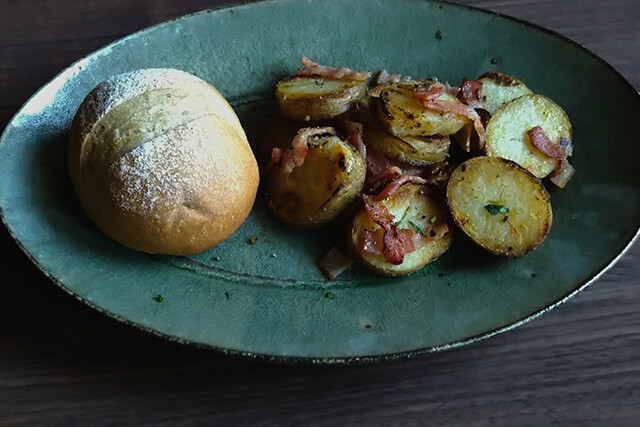
The desire to make tableware began to grow, and Mr. Kiyooka switched jobs to work at a ceramics factory that made tableware. He began making mass-produced vessels at the company during the day, and after work, he began to work on the potter’s wheel in his own workshop. This lifestyle continued for 10 years, but gradually he began to feel a sense of discomfort in his work.
I was in charge of developing new products, but the gap between what could be sold as a product and what I wanted to make was getting bigger. I found that the pieces with a different glaze flow, which would have been rejected as “B” pieces, seemed better to me. This feeling that what he wanted to make was not wanted here drove him to become independent.
Different places accept different products in different ways.
When he first started out on his own, Mr. Kiyooka’s unique creations were not well understood. One day, he participated in a craft fair in Matsumoto for the first time, recommended by others, and sold out on the first day. He was surprised to find that there were so many people who accepted his style, even if the place of presentation was different.
He was surprised to find that there were so many people who accepted his style if he presented his work in a different location. Gradually, the number of people who understood his work increased, and the number of galleries that carried his work also increased.
Something that seems to exist, but doesn’t.”
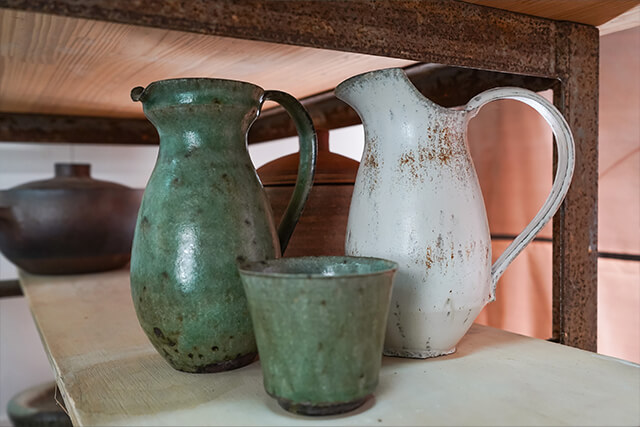
What Mr. Kiyooka values is ” something that seems to exist but does not. The shapes are simple and easy to use, yet they are not something that can be found anywhere.
Take, for example, the jugs on the shelves in his workshop. Although it is ceramic, it has a metallic texture and an antique-like taste. In order to create an iron-like atmosphere, the vessel is not thick. When you lift it up, expecting it to be heavy, you may be surprised to find that it is so light and thin.
If I were the user, I would enjoy thinking about what I would use it for, so I try not to put too much thought into how I would use it, ” he says.
Olive ash glaze with deep colors
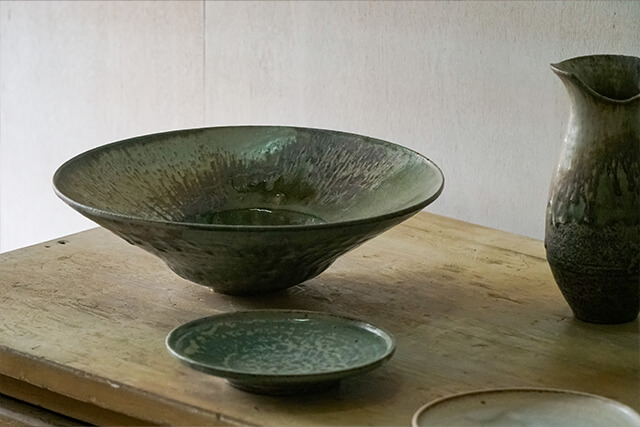
One of his recent masterpieces is a piece using olive-colored ash glaze. This is achieved by using a firing method called “cooling reduction” in a gas kiln, which produces a gradation of flowing glaze. Failure is a given. If you don’t fail, you won’t discover anything new,” he says. He found that an electric kiln produces too beautiful a finish, and a wood-fired kiln is too accidental and uncontrollable, so he settled on a gas kiln.
The flame of a gas kiln produces a unique deep hue. The glaze creates a unique deep color, and no two pieces are alike, with different expressions depending on the angle of view. It is a beauty that one could stare at forever and never get tired of.
To give shape to an ideal image
To give shape to the ideas in his head, he began using ” tatara molding ” about four years ago. Tatara molding is a technique in which clay, stretched into a plate-like shape called tatara, is pressed into a plaster mold. Tatara molding is mainly used to make oval plates. The elliptical pattern can be rounded, slender, and in a sense limitless, so it is easier to express complex shapes with tatara than with rokuro,” he says.
He says that he is often inspired by the reactions of customers at his exhibitions. He is always willing to take on new challenges in pursuit of the ideal forms that spring up in his mind.
Pursuing an unseen landscape

While working, Mr. Kiyooka listens to other people’s voices on the radio or YouTube. He says shyly, “Maybe I miss the sound of other people’s voices because I’m alone all the time,” revealing a charming side to him.
I feel like my sense of what is just right is changing little by little,” she says. At first, I tended to express cool-looking vessels with a lot of decoration, but when I put them on the table, their presence was too strong…. I have changed to dishes that retain the texture of the clay and fit in well with other dishes when placed together, and that complement each other without being too assertive when served.
Mr. Kiyooka’s next goal is to go abroad. He says he would like to see the reaction of people in European countries such as Denmark, France, and Spain. He is looking forward to seeing how his works, which are unlikely to be found anywhere else, and which do not resemble anyone else’s, will be accepted abroad, beyond nationality.
The combinations of clay and glaze are limitless. I am sure there are views that no one has noticed yet. I want to challenge what no one has done before. In the way he answers our interview without hesitation, a quiet passion can be seen. His stoic pursuit of his own expression without being bound by conventional frameworks is sure to shake off the concept of Shigaraki ware and create a new genre of Kiyooka Yukimichi.



